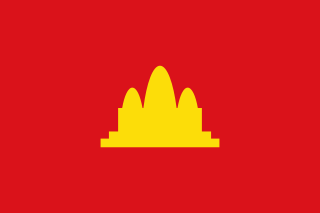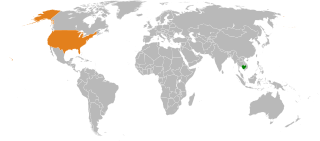The history of Cambodia, a country in mainland Southeast Asia, can be traced back to Indian civilization. Detailed records of a political structure on the territory of what is now Cambodia first appear in Chinese annals in reference to Funan, a polity that encompassed the southernmost part of the Indochinese peninsula during the 1st to 6th centuries. Centered at the lower Mekong, Funan is noted as the oldest regional Hindu culture, which suggests prolonged socio-economic interaction with maritime trading partners of the Indosphere in the west. By the 6th century a civilization, called Chenla or Zhenla in Chinese annals, firmly replaced Funan, as it controlled larger, more undulating areas of Indochina and maintained more than a singular centre of power.

The Khmer Rouge is the name that was popularly given to members of the Communist Party of Kampuchea (CPK) and by extension to the Democratic Kampuchea through which the CPK ruled Cambodia between 1975 and 1979. The name was coined in the 1960s by Norodom Sihanouk to describe his country's heterogeneous, communist-led dissidents, with whom he allied after the 1970 Cambodian coup d'état.

Pol Pot was a Cambodian revolutionary, politician and communist dictator who oversaw mass atrocities during his tenure as Prime Minister of Democratic Kampuchea between 1976 and 1979. Ideologically a Maoist and a Khmer ethnonationalist, Pot was a leader of Cambodia's Communist movement, known as the Khmer Rouge, from 1963 to 1997. He served as General Secretary of the Communist Party of Kampuchea from 1963 to 1981, during which Cambodia was converted into a one-party state. Between 1975 and 1979, Pot perpetrated the Cambodian genocide, in which an estimated 1.5–2 million people died—approximately one-quarter of the country's pre-genocide population. In December 1978, Vietnam invaded Cambodia to remove the Khmer Rouge from power. Within two weeks, Vietnamese forces occupied most of the country, ending the genocide and establishing a new Cambodian government, with the Khmer Rouge restricted to the rural hinterlands in the western part of the country.

Norodom Sihanouk was a member of the Cambodian royal house who led the country as King and Prime Minister. In Cambodia, he is known as Samdech Euv. During his lifetime, Cambodia was under various regimes, from French colonial rule, a Japanese puppet state (1945), an independent kingdom (1953–1970), a military republic (1970–1975), the Khmer Rouge regime (1975–1979), a Vietnamese-backed communist regime (1979–1989), a transitional communist regime (1989–1993) to eventually another kingdom.

The Kingdom of Cambodia, also known as the First Kingdom of Cambodia, and commonly referred to as the Sangkum period, refers to Norodom Sihanouk's first administration of Cambodia, lasting from the country's independence from France in 1953 to a military coup d'état in 1970. Sihanouk continues to be one of the most controversial figures in Southeast Asia's turbulent and often tragic postwar history. From 1955 until 1970, Sihanouk's Sangkum was the sole legal party in Cambodia.

The Cambodian–Vietnamese War was an armed conflict between Democratic Kampuchea, controlled by Pol Pot's Khmer Rouge, and the Socialist Republic of Vietnam. The war began with repeated attacks by the Kampuchea Revolutionary Army on the southwestern border of Vietnam, particularly the Ba Chúc massacre which resulted in the deaths of over 3,000 Vietnamese civilians. On 23 December 1978, 10 out of 19 of the Khmer Rouge's military divisions opened fire along the border with Vietnam with the goal of invading the Vietnamese provinces of Đồng Tháp, An Giang and Kiên Giang. On 25 December 1978, Vietnam launched a full-scale invasion of Kampuchea, occupying the country in two weeks and removing the government of the Communist Party of Kampuchea from power. In doing so, Vietnam put an ultimate stop to the Cambodian genocide, which had most likely killed between 1.2 million and 2.8 million people — or between 13 and 30 percent of the country's population. On 7 January 1979, the Vietnamese captured Phnom Penh, which forced Pol Pot and the Khmer Rouge to retreat back into the jungle near the border with Thailand.
The Khmer Krom are ethnically Khmer people living in or from the Mekong Delta, the south western part of Vietnam known in Khmer as Kampuchea Krom. The Khmer Krom people are considered an the indigenous people of parts of Southern Vietnam and have the oldest extant recorded history of inhabiting in the region. In Vietnam, they are recognized as one of Vietnam's fifty-three ethnic minorities.

The Khmer Issarak was a "loosely structured" anti-French and anti-colonial independence movement. The movement has been labelled as “amorphous”. The Issarak was formed around 1945 and composed of several factions, each with its own leader. Most of the Issarak factions fought actively between the end of the Second World War in 1945 and Cambodia’s independence in 1953. The initial objective of the Khmer Issarak was to fight against the French in order to gain independence, before later focusing on overthrowing the Cambodian government. The term Issarak originally referred to non-communist, but in the early 1950s the Việt Minh-guided guerrillas branded themselves Issaraks for the sake of unifying other non-communist forces.

The Coalition Government of Democratic Kampuchea, renamed in 1990 to the National Government of Cambodia, was a coalition government in exile composed of three Cambodian political factions, namely Prince Norodom Sihanouk's FUNCINPEC party, the Party of Democratic Kampuchea and the Khmer People's National Liberation Front (KPNLF) formed in 1982, broadening the de facto deposed Democratic Kampuchea regime. For most of its existence, it was the internationally recognized government of Cambodia.

Democratic Kampuchea was the official name of the Cambodian state from 1976 to 1979, under the totalitarian dictatorship of Pol Pot and the Communist Party of Kampuchea (CPK), commonly known as the Khmer Rouge. The Khmer Rouge's capture of the capital Phnom Penh in 1975 effectively ended the United States-backed Khmer Republic of Lon Nol.

The People's Republic of Kampuchea (PRK) was a partially recognised state in Southeast Asia which existed from 1979 to 1989. It was a satellite state of Vietnam, founded in Cambodia by the Vietnamese-backed Kampuchean United Front for National Salvation, a group of Cambodian communists who were dissatisfied with the Khmer Rouge due to its oppressive rule and defected from it after the overthrow of Democratic Kampuchea, Pol Pot's government. Brought about by an invasion from Vietnam, which routed the Khmer Rouge armies, it had Vietnam and the Soviet Union as its main allies.
The earliest traces of armed conflict in the territory that constitutes modern Cambodia date to the Iron Age settlement of Phum Snay in north-western Cambodia.

Bilateral relations between the United States and Cambodia, while strained throughout the Cold War, have strengthened considerably in modern times. The U.S. supports efforts in Cambodia to combat terrorism, build democratic institutions, promote human rights, foster economic development, and eliminate corruption.

Cambodia–Vietnam relations take place in the form of bilateral relations between the Kingdom of Cambodia and the Socialist Republic of Vietnam. The countries have shared a land border for the last 1,000 years and share more recent historical links through being part of the French colonial empire. Both countries are members of the Association of Southeast Asian Nations (ASEAN).

The Royal Government of National Union of Kampuchea was a government-in-exile of Cambodia, based in Beijing and Hong Kong, that was in existence between 1970 and 1976, and was briefly in control of the country starting from 1975.

The Communist Party of Kampuchea (CPK), also known as the Khmer Communist Party, was a communist party in Cambodia. Its leader was Pol Pot, and its members were generally known as the Khmer Rouge. Originally founded in 1951, the party was split into pro-Chinese and pro-Soviet factions as a result of the Sino–Soviet split with the former being the Pol Pot faction, and the latter adopting a more revisionist approach to Marxism. As such, it claimed that 30 September 1960 was its founding date; it was named the Workers' Party of Kampuchea before it was renamed the Communist Party in 1966.

The Cambodian genocide was the systematic persecution and killing of Cambodian citizens by the Khmer Rouge under the leadership of Prime Minister of Democratic Kampuchea, Pol Pot. It resulted in the deaths of 1.5 to 2 million people from 1975 to 1979, nearly 25% of Cambodia's population in 1975.

Khmer nationalism is a form of nationalism found in Cambodia, that asserts that Khmers (Cambodians) are a nation and promotes the cultural unity of the Khmer (Cambodian) race.

Singapore–Vietnam relations refer to the bilateral relations between the Republic of Singapore and the Socialist Republic of Vietnam. Singapore and Vietnam started the trade relations in the 19th century. Due to the anti-communist policy of Singapore, Singapore supported South Vietnam before the unification of Vietnam. Singapore also started formal diplomatic relations with North Vietnam on August 1, 1973. After the unification of Vietnam, Singapore started to improve its relations with the Socialist Republic of Vietnam. Relations worsened during the Cambodian–Vietnamese War, but have improved once more after the People's Army of Vietnam withdrawal from Cambodia.

The Cambodian conflict, also known as the Khmer Rouge insurgency, was an armed conflict that began in 1979 when the Khmer Rouge government of Democratic Kampuchea was deposed during the Cambodian-Vietnamese War. The war concluded in 1999 when remaining Khmer Rouge forces surrendered. Between 1979 and the 1991 Paris Peace Agreements, it was fought between the Vietnam-supported People's Republic of Kampuchea and an opposing coalition. After 1991, the unrecognized Khmer Rouge government and insurgent forces continued to fight against the new government of Cambodia from remote areas until their defeat in 1999.













